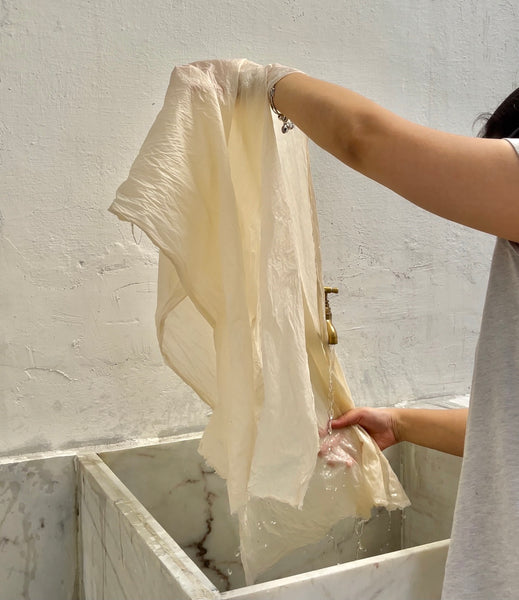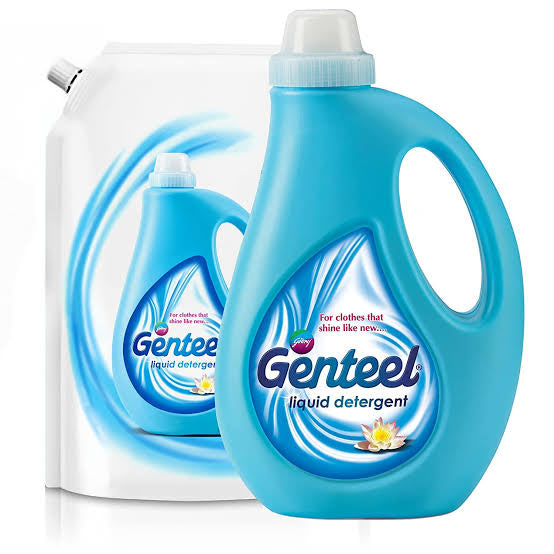When I first started my natural dyeing journey, I had no clue about scouring. Eventually when I started learning about it, researching, adding professional knowledge regarding this, I came to know the term scouring and very honestly I never learnt about it in my fashion & textile college either.
I did not take it seriously, I thought it's just washing the cloth, I can simply wash it in the machine and it will be done. As soon as I got indulged in my process more and more, and the more I dyed, I came to realisation that scouring is a very crucial and an extremely underrated stage when it comes to dyeing in general.
Scouring : A term referring to the cleaning of a fabric and not washing of a cloth.
By cleaning of the cloth, in simple terms I mean to say that when the cloth/fibre is produced, it not only goes through a lot of process but even due to their natural circumstances they have impurities which needs to be cleaned before you mordant or dye your textile.
Traditionally it was done in large pots filled with water, the fabric would simmer in an alkaline solution (majorly cottons and other cellulosic materials) to remove impurities. Once the water became murky, it would be drained off and the process was repeated until the water ran clear.
Let's Begin!
We will work with steps in this blog and begin with identifying our fabrics and fibres, learn about scouring ingredients that are used widely & professionally around the world specifically by natural dyers and finally narrowing it down to the materials that can be found in the Indian region and are suitable to work with. We will then pick our fibres, measure the materials of scour and then frame up our recipe!
I couldn't find articles as such for scouring your fabrics in Indian Household as most of my participants and students work in their kitchens so I have focused on that part as well. <3
Also I tell my students to believe in their knack and intuition when it comes to natural dyeing because that usually works the best and always frame up their own recipes so I will suggest you to do the same just don't forget to record it, and yes if in-doubt always experiment first, that ways you will keep learning about new things.
Why should you Scour?

Fabrics sold as gray goods or “greige” require a thorough scour for sure! Even products that are sold as Ready for Dyeing (RFD) or Prepared for Dyeing (PFD) often need a light scour before you mordant or dye.
Removing these contaminants through scouring prepares the textiles for subsequent processes such as mordanting and dyeing.
Though a general term, "scouring" is most often used for wool. In cotton, it is synonymously called "boiling out," and in silk - "boiling off".
In any case, please do not skip this step.
How to scour?
As mentioned above now we will go step by step and learn about each step in details with their facts.
Identifying Fabrics/Fibers

The Natural fibres/fabrics are divided into two groups : Cellulosic and Protein.
This information is something that will decide all the paths that you take for dyeing the material basically.
From scouring to mordanting to dyeing, the first step is always to identify the materials. The process to scour Proteins such as Wool and silks is different than cellulosic materials such as Cotton, linen, Hemp etc.
- Cotton and other plant fibres require scouring to remove waxes and pectins. So the recipe which is used for scouring cellulosic materials is different than of proteins.
- Fleece and wools need to be scoured to remove natural oils (lanolin) and dirt. Some fleece sold as scoured has also been oiled to facilitate spinning - it will need to be scoured again.
- Silks require scouring to remove sericin - the coating of the fibre that held it into a cocoon.
So we opt for different recipes, depending on of course the type of material. I never suggest my students to follow the recipe word to word, the knack of your own judgement is the best way to form recipe and whenever in doubt, experiment first.
Picking your Scouring Material
So usually it's always a confusion what kind of detergent or soap one should go for and what all can one use when it comes to scouring, also why are we doing what we are doing.
I come from India and over here even though we have a variety of soaps/detergents available for us, but we aren't really focused on what kind of soap should be used by natural dyers specifically. Many people just try to work with ph neutral soaps or detergents or use mild detergents but as to the reasoning of it, many of the dyers are unaware as to why they're following a scouring recipe and what importance does the quantity, composition of the scour and its effects plays on the cloth.
Websites like Maiwa, Botanical colours, Dharma Trading Co. and there are more, they have a very detailed section as to what should be used for scouring and where can you get it from. Three of the highly recommended scouring materials I could get my hands on was Orvus Paste, Eucalan and Synthrapol even though on their websites it is pretty reasonable but in India, I couldn't find a simpler place to get it from, I tried Amazon but it was either unavailable or too expensive.
But we are anyhow going to learn about Synthrapol, Orvus Paste and Eucalan because educational purposes as to why dyers and well known brands like these recommend them.
Orvus Paste
- It's really a detergent, not a soap, made of 100% sodium lauryl sulfate (SLS), with a neutral pH that is completely biodegradable.
- Also it doesn't contain bleaches, enzymes, sulphates, fillers, brighteners and other chemicals that might affect textiles. This means it is great for scouring your proteins such as silks and wool.
- It is also for washing them after the dyeing to restore lustre and protects the natural dyes from fading away too quickly because it has no chemicals which could harm these properties.
Eucalan

- Eucalan Delicate Wash is non-toxic, biodegradable, free of optical brighteners, phosphates, synthetic fragrance and dye. Eucalan is pH neutral and is packaged in an easy to recycle, dye free HDPE plastic bottle.
- The lanolin acts as a natural conditioner, keeping fibres supple and reducing static. The name 'Eucalan' forms with Eucalyptus + Lanolin.
- It is also said that it biodegrades quickly.
- I recommend you to read more about this brand on their website as they have a very interesting history to it .
Synthrapol

- It is a non-ionic special detergent which is pH neutral as well. It is used in scouring fibres before dyeing, and in washing out fibre reactive dyes after dyeing. It's used in several phases of dyeing; it is composed of water, isopropanol and detergent.
- Majorly used for Cellulosic materials.
- It will remove sizing from the fabric before colouring, remove excess dye, Let's say someone didn't prewash their fabric after dyeing it, sewed lights and darks together in a quilt and the colour from the dark bled to the light. Synthrapol will remove the colour transfer.
- It is also sometimes used as a surfactant or wetting agent to improve dye penetration.
- Again it is difficult to find in the Indian market but many dyers around the world recommend this for scouring cellulosic materials.
One more ingredient which is used very widely for the scouring for cellulosic materials is Soda Ash, I have focused on it in the next section as it is used a lot by the indian dyers as well.
Scouring Materials specific to Indian Market
Alright so when it comes to selecting a Scour Material, it is very important that you pick a formula which is pH neutral as high or low pH levels can affect the strength of your cloth, the chemistry bond of your dyes when you work with mordants & dyes later on and change the colours as well because natural dyes are usually very pH sensitive. Secondly I try to find formulas which aren't soda based as well because I have a separate step for soda ash while I scour.
I have listed out three of the detergents that I love working with one is Ezee which I use for my proteins and Koparo which I use for my cellulosic. For cellulosic fabrics such as cotton I also use my normal laundry detergent sometimes but I try to look for detergents with no soda formula so you can opt for something like Genteel because I like to give my cellulosic fibres a boil of washing soda separately.
Ezee

- I personally don't like using powder detergents, so for me liquid ones work the best. I have been using Ezee for a pretty long time, even before I started using it for my naturally dyed products.
- The best part about it is that I can use it for scouring as well as the detergent for post dyeing processes.
- The pH neutral, no soda formula – prevents from shrinking, fading and avoids loss of protein, damage of fabric as well as colour loss which works for natural dyed fabric as well.
- It is also approved by Woolmark Company for washing wool.
Koparo

- I recently started using it and it is pretty good with stains specially for cottons as well! though it is slightly expensive but worth it.
- It has Coconut and sugarcane based surfactants, natural anti-microbial agents, plant based extracts and essential oils.
- It has 0% added phosphates, parabens, ammonia, chlorine, EDTA, phthalates, triclosan and no added synthetic dyes. The product is also PETA certified to be vegan and is 100% cruelty-free.
- This is a neutral pH and no soda formula as well, which you already know is beneficial.
- I use it for my cellulosic materials majorly.
Also they have a brilliant website and the way they have explained everything there is beautifully done, highly recommend you to see it to learn more about them as its super informative and educational as well.
Soda Ash

- Besides this for the cleaning for cellulosic materials, most of the scouring recipes (everywhere around the world) recommend the use of Soda Ash/ Washing Soda/ Sodium Carbonate.
- It is majorly used to make the water hard by bumping up the pH to help remove stubborn starches and residues on your cloth before dyeing, that is why it is used with cellulosic as it is filled with waxes and pectins which are difficult to remove with usually just detergent.
- Also keep in mind that don't exceed the quantities during scouring as it might bond with the fibre and aid to modifying of the colour in later stages.
Genteel

- The liquid detergent is great for whites as well as your coloured clothes. So I use this for both my proteins as well as cellulosic but for my proteins I still prefer Ezee.
- Genteel has an added fabric conditioner that softens the fabric and leaves your clothes with a lingering fragrance which I'm not fond of but doesn't affect my results.
- The pH-neutral no-soda formula prevents your clothes from shrinking and fading.
Soap Berries

Recently I have been trying my hands of Soapberries/ Reetha/ Soapnuts as well for scouring.
- Soap-nuts are dried Berries in the Sapindus Family.
- High amounts of Saponins are found in the berry skins and is good alternative to synthetic detergents when dried. It is used for cleaning bodies, hair and clothes.
- The soap nut solution's pH depends on how much saponin it has but in general I have realise that it is slightly on the acidic side which is between 4-6 pH which is ideal for both hair and skin so it should work fine for silks as well.
- I personally feel that using it with cellulosic fibres are much better than with proteins because it makes the proteins slightly hard.
- But it works great for using it as a cleaner after my clothes are dyed (Post processing) I have been using it for a while and it hasn't affected my results.
Making your own Recipe
Calculating the WOF
 Once you decide the material that you are planning to work with, you will need to calculate how much Scour you'll be needing to clean your cloth. We start by taking the W.O.F. --> Weight of Fabric/Fibre, which refers to the dry weight of the yarn/fibre/fabric, which then allows you to calculate how much detergent or cleaning agent you need.
Once you decide the material that you are planning to work with, you will need to calculate how much Scour you'll be needing to clean your cloth. We start by taking the W.O.F. --> Weight of Fabric/Fibre, which refers to the dry weight of the yarn/fibre/fabric, which then allows you to calculate how much detergent or cleaning agent you need.
Calculating the Scouring Agent
*Please note, these calculations are specific to the scouring agents that I have written about for the indian market.
For Wool
- For the woollen yarns that you buy from the market, you can use 5-8% of detergent according to the W.O.F. For example, for 100 grams of commercially prepared yarn, you would use 5 - 8 grams of detergent.
- For raw wool or organically processed yarns, use 10% WOF.
- If your wool or yarn feels exceptionally greasy or dirty, use up to 12-15% WOF.
For Silk
- Use 5-8% of neutral detergent according to the W.O.F.
- You can use Soda Ash as well for silks only if you think its very dirty, but I never use it, what I usually do is, I use low to moderate temp. like 30-50° C and keep changing the water till it starts appearing clean.
- Sometimes the first baths are just in warm water and no detergent, so the cloth becomes very absorbent as well as starts realising its dirt.
- Just incase if you use soda ash, I highly recommend you to use only 1-3% and if incase the cloth is too dirty, you can go up to 5% but try avoiding high quantities because soda ash can make your silk hard, but if in doubt, first experiment and then implement it on the entire quantity.
- If you are using soda ash you'll be needing white vinegar (It is usually 10-20% of acetic acid and rest is water) Use 5% WOF of white vinegar to neutralise the fibres after scouring.
For Cellulosic
- The recommended amount of detergent for cellulosic is 8-10% of the WOF, or approximately 1 teaspoon for 100 grams of fibre, but sometimes if it is too processed or dirty, I use 10-12% detergent as well.
- The amount of soda ash that I use is 3-4% of the WOF, or approximately 1/4 – 1/2 teaspoon for 100 grams or 4 ounces of fibre. If your fabric feels particularly dirty or greasy and is a heavy weight fabric, use 5-6% WOF.
Notes :
- Always remember, never scour on high heat, increase the temp. gradually, for cellulosic you can go up to 100-120° C and for proteins 60-70° C max.
- Never mix any sort of detergent, soda ash directly into the pot or over the yarns, always take another vessel, preferably glass, stir and mix everything in there and then add this solution to the water pot, and that too after the water has gradually become hot. If you mix this solution in cold water, it won't have any effect.
- While working with yarns, it is always better to make skeins.
- The size of the pot should be big enough so your fabric or yarns aren't over crowded in the pot and can float freely.
- If the water appears to be dirty, you might have to repeat the process until your water becomes clear and that's how you'll know you have scoured well.
We hope this clears most of your doubts about Scouring and its importance while dyeing the textiles. We have tried to cover as much information as possible but yet if you have any doubts regarding the process, please feel free to write to us at admin@heenaagrima.com
You can also learn more about this in our Online Natural Dyeing Workshop that is held monthly. Please find more details about it here.
We will be back with more information via our blogs soon!
Lots of Flowers,
HeenaAgrima
<3





7 comments
Very helpful read . Will get in touch if I need more details. Thank you
Very descriptive & precise explanation on scouring . Keep up your work. Hope to hear more information on natural dyeing materials available in India. Thank you & best wishes .
Dear Heena & Agrima,
This is an elaborate article which has covered all points exhaustively. Definitely a collector’s piece.
Your ready to use article has value added to my knowledge about scouring.
Thank you for the information.
Looking forward to many more such articles.
Very very informative n useful article
This will help us
Love u 💓
The article has described the entire process in descriptive yet easy language for beginners. The article clears almost all the doubts with some reasonable and easily accessible washing alternatives. Kudos to you guys! Keep up the good work. Can’t wait to read more!
You're viewing 1-5 of 7